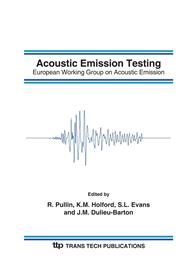p.213
p.223
p.231
p.237
p.243
p.253
p.259
p.267
p.273
Detection of Stress Corrosion Cracking of Type 304 Stainless Steel Using Acoustic Emission and Corrosion Potential Fluctuation
Abstract:
This paper discusses the mechanism of chloride SCC of sensitized and non-sensitized Type-304 stainless steel based on the data obtained by simultaneous monitoring of AE and corrosion potential fluctuation (CPF). The steel produced transgranular SCC via corrosion pits filled with corrosion product (chromium oxy-hydroxides) in 35 mass % MgCl2 solution. Both the pitting corrosion and transgranular SCC did not produce primary AEs due to anodic dissolution, while they generated rapid drop (RD) type CPF. We, however, detected the secondary AEs from hydrogen gas evolution and fracture of corrosion products. Hydrogen gas was found to produce AE with single frequency component, while the fracture of corrosion products produced AEs with broad frequency components. The sensitized steel produced primary AEs due to the falling-off of grains as well as the secondary AEs. Microscopic progression of SCC was consistently interpreted by the timing and time-lag of AEs and CPFs.
Info:
Periodical:
Pages:
243-250
Citation:
Online since:
February 2006
Authors:
Price:
Сopyright:
© 2006 Trans Tech Publications Ltd. All Rights Reserved
Share:
Citation:


